The Witness introduces another beautiful, puzzling world from Jonathan Blow
Interview: we learn all about the world we can't stop exploring

Since famed game designer Jonathan Blow released Braid – the platform-jumping puzzle game that helped put independently developed (or "indie") games on the map – for the Xbox 360 in 2008, a lot has changed in the gaming world. A new generation of consoles has landed, all well-connected to foster what's become a comparatively thriving indie game scene.
This week, Blow pops his head up above ground once again with a new creation, his first in over seven years: The Witness. Like his first major release, The Witness is a new world to explore, a new story to experience and a new kind of logic to exploit – painstakingly crafted down to the pixel.
But rather than the two-dimensional realm of Braid that was akin to, say, Super Mario Bros., The Witness is a 3D world rich with color and plentiful in character. The trees and grass sway in the wind that moves the white clouds (except for that weird gray one).
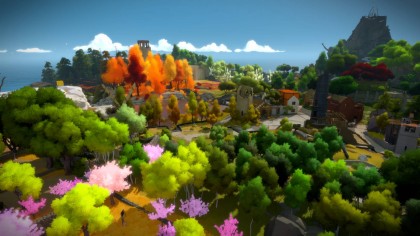
The world that you awake to in The Witness is one you only experience after emerging from inside a dark tube. You have no idea how your character – presumably a young adult male by the look of his shadow – arrived here.
The vibrant, surreal world that greets you upon reaching the surface is a seemingly lifeless island rife with panels that power various gates, the key to opening which being a series of increasingly difficult line puzzles. As you eventually open the main gate, you begin to wonder whether you (the character, of course) were placed in Blow's island world for a reason, and if so, by whom?
After a few hours into The Witness, it seems like Blow has bottled that lightning again. The Witness is an eerily quiet yet stunningly beautiful world that can, at times, frustrate with its puzzles.
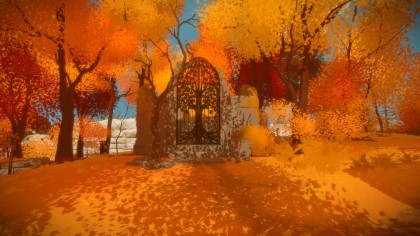
But the rewards for completing those mind teasers, from simply new vistas from which to admire Blow's creation to nuggets of a creepy sci-fi tale delivered powerfully through audio tapes left behind by four (assumed) former island inhabitants, are so very worth it. (This one's a contender for the best indie games of 2016, no doubt.)
Get daily insight, inspiration and deals in your inbox
Sign up for breaking news, reviews, opinion, top tech deals, and more.
I recently caught up with Jonathan Blow to bend his ear a bit about The Witness, from its '90s era inspirations to what's so damn cool about puzzles (seriously, this guy loves them), and he was refreshingly frank with me throughout. Here's a record of our conversation edited for legibility and brevity, in which we gush a bit about VR gaming, too.
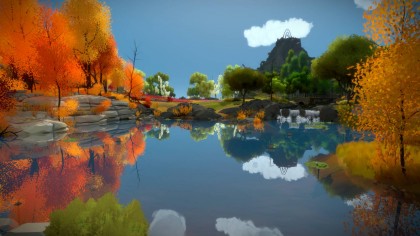
Techradar: This game has been in development for quite some time, so how does it feel to get another creation out there after having labored over for this long?
Jonathan Blow: This might be a little early, because the game's not out there yet, but it's good. I've been working on this for forever, right? It's a crazy amount of time to devote to something like that, and it's a relief that it's done.
... [the game is] probably, for most players, between 70 and 120 hours ...
You know, I had no idea it would take this long to make the game. For me, it's been almost 7 years, which is huge – that there is a large portion of my life. (Laughs.) Other people on the team came on later. For most of them, it's been about 4 years, and for a couple people it's been longer than that.
And how big is your team now?
We have something like six or seven core, full time people. But in the course of making the game, we've ended up working with more than a few contractors working here as well as a number of external people – architects, sound designers, stuff like that. At peak, the number of people working on the game at once was probably something like 16.
That's a lot for an independent game, but it's very, very small compared to a triple-A game, which may get like hundreds of people working on it.
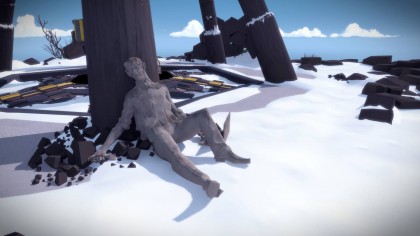
What inspired you to go with the slightly more realistic art style in The Witness, as opposed to the more impressionistic style of Braid?
Every game is a little bit different in terms of what it wants. Whatever the ideas are behind the game. There are choices you can make in terms of visual or sound design that can reinforce those ideas, and there are choices you can make that can weaken those ideas.
Now, as a designer, my job is to pick the sources that strengthen those particular ideas, to make a unified experience. For this game, I would say there is actually a combination of realism and non-realism at the same time.
In terms of the construction details of the wall, that's realism. When you go into a building, that building was designed by a real-world architect. There are structural supports in places where there would be such things within a realistic building. They are modeled, there are bolts in the right places – those are not things that games usually do.
That is a very realistic thing. On the other side of it, though, our choice of colors is highly unrealistic, for example. They're very saturated and extreme colors that you don't typically see in the real world.
That seemed like just the right mixture for this game.
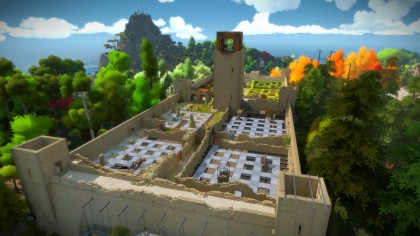
I assume that the visual tricks that fans have picked apart in trailers – i.e. the cliff face that depicts the facade of a women through its reflection – are intentional. How many more of those nods can players find in the game, and what was your goal in creating those little nuggets?
The game is full of that kind of stuff, really, and there are many layers of it. Some layers of it are what you just described: something to see or something to notice. Some other layers are more puzzly.
... it's actually very deliberate that The Witness riffs on Myst ...
There are some puzzles in the game that are tucked into corners that you really have to look for. There are some audio recordings that are tucked into corners that you really have to hunt to find out, and, if you're not that interested in them, maybe you don't do that kind of search, right?
What it's all there for is to give the game many layers through which you can engage with it. If you want to just kick back and play the game at a more casual level, you can. But, if you really like it and you really want to get into it, and really explore intensely, then the game has things for you.
You can engage with it at many layers of depth, which is something that happens a lot with many other forms of media. You could read a novel and really, really enjoy it and read it five times and get more out of it every time, or you could read it just once and be like, "That was a really cool story."
We're just trying to design something that permits multiple kinds and multiple levels of engagement.
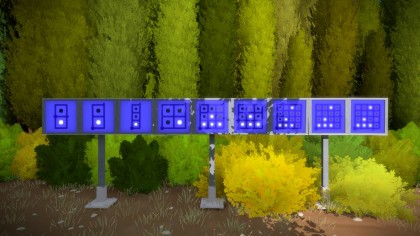
You appear to be very much focused on puzzles in your games, Braid itself being a puzzle. Is that purely because that's simply the kinds of games you enjoy making, or is there something else driving you toward that style?
I certainly like puzzle games and I like to make them, but as game three and four happen, they're probably not going to be centered around puzzles the way these two have been. It's just that those are the kinds of ideas I had for some time.
Now, there is something interesting about puzzle games, which is this non-verbal communication that interests me very much as a designer. I work very hard to make my games communicate non-verbally where they can.
Puzzles allow that communication to be a little more two-way in that solving the puzzle isn't really just a brain teaser most of the time. It's that the player expresses that they understand some communication that has happened. So, then the conversation can go onto the next step.
So, when you walk up and see another of these rows of puzzles, it's not just a series of puzzles but more so a paragraph of ideas. Each puzzle has its own little piece of the idea, and when you go through that, it's like reading sentences but in a different mode of communication.
Puzzles just allow for that, whereas with action games, it's not really the same. The communication can't quite be the same. So, exploring that communication kind of came out as puzzles. In another game, it would come out differently.
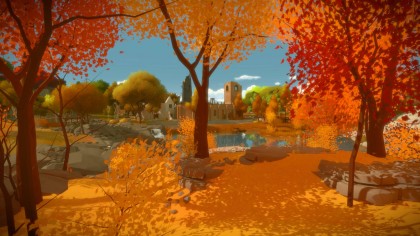
By no means being reductive, how much of an influence have games like Myst been on you as a game designer or just as a game fan in general?
I really enjoyed Myst, but I didn't quite play it when it came out, but I played it a little bit later when I had a PC wherein you could just copy the whole game to the hard drive and off the CD. That was cool, because you could play Myst a lot faster than if you were just sitting there waiting for the CD.
I really enjoyed Myst at the time, but as a game designer that thinks really hard about what's going to be in my game, I have a lot of problems with the game design evidenced there. But it was also a very pioneering game.
Myst gets a bad rap sometimes, some game critics really like to bag on it. But I actually think it was a good game in a lot of ways. And in several ways, I can appreciate it even today.
So, it's actually very deliberate that The Witness riffs on Myst and games within that genre of games that that spawned, which have mostly died out at this point. Maybe we're seeing a slight resurgence in the first-person adventure, but not really. There still aren't that many, but it used to be huge.
For a couple of years, everybody was making a Myst clone. Most of those clones were terrible, but it just shows you what a good game that was.
... it's a game ... that respects you as a player in that it believes that you're smart ...
So, in terms of mood and setting, The Witness is very deliberately a callback to Myst. You're alone on this island, and there are puzzles on the island and it's a little bit surreal. If you go back to Myst it was, like, a rocket ship next to an observatory, next to, like, a sunken pirate ship – all of this weird stuff that was juxtaposed in such a way that just wouldn't happen in reality and packed really close together.
I wanted to do that again, of course the space we're making is huge compared to the space in Myst and offers a lot more freedom of motion. But that sense that you're in a place of – well, we have a deserted island next to an apple orchard that's kind of weird. But we make it work somehow, I think.
So, Myst has been a very positive influence, but it also serves as [warning of] things to stay away from. There are things, like I said, in games like Myst and those that followed it that I think can be done better.
I think we know a lot more about game design today. So, the design of The Witness, and what you do as a player, is very much not like Myst in many ways.
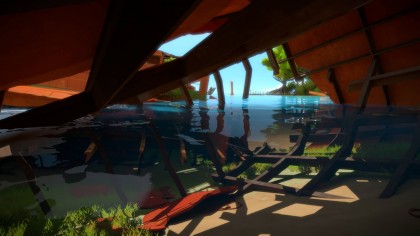
Speaking of trends, i.e. Myst's release inspiring a bunch of derivatives, what would you say has been the biggest change in gaming between Braid's release and now The Witness?
I don't know if there's just one – it's just really different. There's a wider variety of games happening now. We went through a time for a while when it was very expensive to make games. And around the time of Braid was the beginning of when it became viable to make smaller games that were also interesting – and get distribution for them, thanks to the internet.
That trend has just gone a lot further now, to the point now where there's just a ton of interesting games.
At the same, at the high end of the triple-A end, there are fewer games, actually, many fewer than there were back then, because budgets have gone way up and risk is so high. That landscape has just changed, and anyone who wants to make a game has to just figure out how to navigate that for themselves.
And, for anyone who wants to play a game, I don't know. I think the variety is good for players, but like I said, there's also a lack of variety in the triple-A. [That sector] is more homogenous and has fewer choices than ever in history. I'm not sure that's so good.
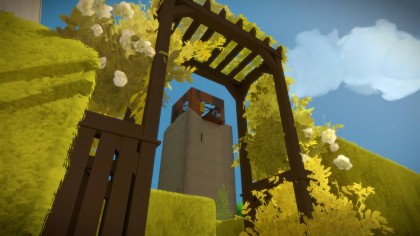
We all draw the corollaries between Hollywood and the gaming industry, and I don't think there's anything within the past couple of years that has disproved any of those comparisons. Now, jumping back to the game itself, what was it like working with voice talent for the first time?
For me, for a while it was agonizing, because I was doing it in not a very good way. I was going to websites and having freelancers interview and such, and we were getting a lot of cringe-worthy stuff. I was despairing that we would ever have good voice acting, like this is so hard.
But, at some point, our audio guys hooked us up with some people at Warner Brothers, like a WB game audio division, and they directed our voice acting and did all of the auditions. And we immediately got just like amazing auditions, and as soon as that happened I thought, "Well, this is great."
We took a bunch of callbacks and then we took the best out of the callbacks – once you have good actors working on your game, it's just a real pleasure.
You start good, and then it only gets better as you work on the pieces and refine them. It was actually highly enjoyable once we got it worked out. Now, we were able to go to Warner Brothers and then record it in a serious studio with serious voice actors, and that stuff is not totally cheap.
It's because we had a budget for this game that we were able to do that. Someone working on an indie game from their bedroom may not have such a gravy time with that. At which point, they have to get lucky, I guess.
For me, it was eye-opening to just go into Warner Brothers that are just in the middle of the Hollywood environment where they do this all of the time. That just makes it so much easier to do in that they just know how to do it, and it works. That was pretty fun, actually.
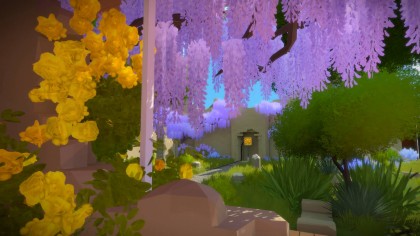
Seven years is a relatively long time to spend developing a game, so what's the most significant change that the game endured in its seven-year development period?
The biggest surprise was that. in the beginning, I thought we were making a much smaller game than we ended up making. In 2009, when I announced that I first put together the initial company, I had said mid-2011 for release date – late 2011, something like that.
Obviously, it took us much longer than that. Part of the reason that happened was just because in the thing that we were making we saw a lot of cool opportunities to follow. And we had the ability to follow them, because we're making this for a triple-A publisher that's demanding a certain schedule.
We were able to set our own schedule and go, "Look, we're going to make this the game that we want it to be, so let's just do it."
It's hard to say how big the game is – because how do you describe that? – but it's probably, for most players, between 70 and 120 hours, depending on how fast you are with puzzles. Also, whether you want to be totally completionist.
You can get to an ending in a lot less time than that. But, if you really want everything the game has to give you, it's that big of a game. And it just takes a lot of time to build all of that stuff. That's a triple-A amount of stuff or even more.
A lot of triple-A games can be 8 to 10 hours. So, that was the surprise, and that sort of snuck up on us somewhere between 2011 and 2013 as we kept building it out.
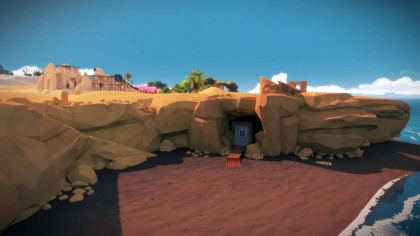
How would you present The Witness to someone that hasn't played much more than, say, Super Mario Bros. and Pac-Man or games on their phone – Candy Crush and what have you?
I would say that it's a game about puzzles and exploration, and that it respects you as a player in that it believes that you're smart and lets you go on your own to explore and find what problems you want to solve.
What are your thoughts on VR as a designer? Do you see opportunity there for your own work?
I think it's going to be interesting. I think it's going to take a little bit for the tech to go totally mainstream, but there are some aspects that I think are under-appreciated. Like, the feeling of being there – the visceral part of presence that adds to VR.
I think that the best VR experiences have to be designed for it.
For me, as a designer, what's most interesting is also the controllers, because they give you a much better way to interact with games than we've had. You know, for many years we've had essentially a game pad with a few buttons, or maybe a mouse and keyboard, so you have a little bit of analog input.
But as soon as you got anything that's on, like the [HTC] Vive, its hand tracking controllers – it's also really good with head tracking. Or the Oculus Touch controllers that aren't quite ready to ship yet but will come later in the year, it just makes this giant difference to what you can design and what kind of game you can build, because certainly the player can express themselves a lot more.
If you're trying to squeeze all of your expression of what you want to do through a couple of buttons, it's kind of anemic, because there's not much that you can do. But suddenly, it's actually going to be pretty amazing, what you can do with these controllers. I'm excited about that.
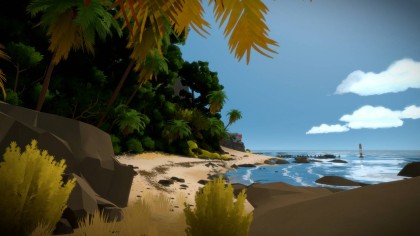
I had a chance to try out the HTC Vive Pre at CES, and it just blew me away.
Well, those controllers are so great. Like, while you're wearing the headset, someone can toss one to you – you can catch it in the air, because it just tracks perfectly.
Yeah, it was pretty amazing when the woman who was running the demo put the headset on my face and handed me the controllers, and I instantly grabbed them – not even able to see my own hands. So, do you see any opportunity in VR for your own work?
I do. I'm not quite getting too serious about designing in VR yet. I'll make games that work in VR probably, like, you can play The Witness with a VR headset.
But I think that the best VR experiences have to be designed for it. I have some ideas in that direction, but I don't have a specific thing that I'm ready to press the button on and say, "Let's go, we're making this."
I like it, and I bet I'll do something for it before too long.
Now, I have to ask because we'll never forget the video (NSFW): have you had a chance to show Soulja Boy The Witness?
(Laughs.) No, I don't know Soulja Boy and I don't hang out with him on a day-to-day. So, I have no idea what he'll think of the game if he thinks of it at all.
The Witness launches on PS4 and on PC through Steam on January 26 for $39.99 (£29.99, about AU$57.26).
- These are the best gaming laptops that money can buy
Joe Osborne is the Senior Technology Editor at Insider Inc. His role is to leads the technology coverage team for the Business Insider Shopping team, facilitating expert reviews, comprehensive buying guides, snap deals news and more. Previously, Joe was TechRadar's US computing editor, leading reviews of everything from gaming PCs to internal components and accessories. In his spare time, Joe is a renowned Dungeons and Dragons dungeon master – and arguably the nicest man in tech.
